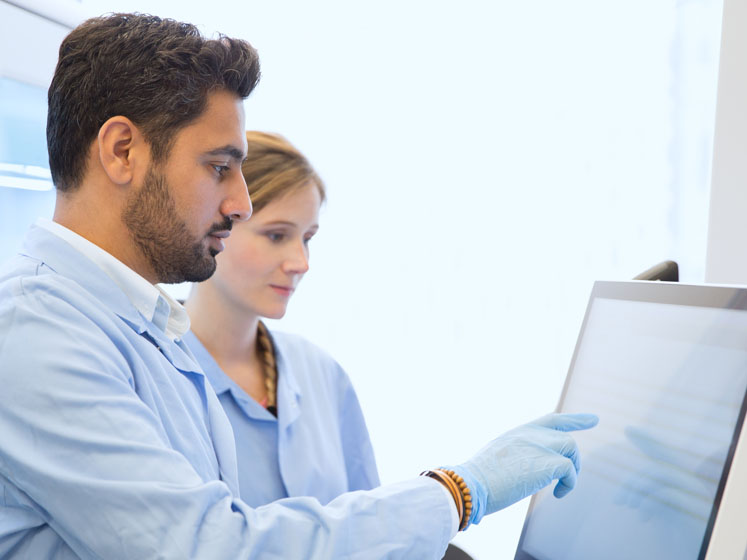Diagnostic laboratories are a critical component of our global healthcare system with in vitro diagnostics influencing up to 70% of all clinical decisions.1,2 Together, medical and lab professionals play a key role in delivering optimal patient care; yet, they face intensifying pressure to manage an increasingly high number of samples while delivering quality results faster with the same or fewer staff.
Fortunately, technological advancements have allowed Roche to evolve diagnostic solutions during the past 50 years. Roche has a strong track record of fusing science innovations in the lab — serum work area (SWA) assays — to create an advanced, fully integrated and automated laboratory solution that maximises productivity while improving the accuracy of diagnosis and breadth of diagnostics knowledge.
“Let me introduce you to the cobas pro system,” says Ann, “which was launched at the end of last year and recently introduced at EuroMedLab, as I think that’s a good place to start.”
Offering excellent performance with a simple-to-use and newly designed interface, the cobas pro integrated solutions is breaking new ground in the serum work area.
It has reset standards for reliability, maintenance and efficiency by lowering the cost of healthcare delivery and increasing customer satisfaction. “It’s an area in which we’ve really worked on improving the technology,” says Ann, “first and foremost we listened to our customers to understand where their pain points are and how we can overcome those hurdles.”
“Clinical labs in general are under a lot of pressure to do more with less; they’re often seen as a cost centre as opposed to a profit centre and frequently suffer from tightening budgets,” she explains: “From that point of view, the most expensive part of running a lab is the people and it’s an area where lab managers and the C-suite are constantly looking to make savings. The cobas pro marks a significant milestone in evolving laboratory diagnostic workflow and continues with Roche’s long tradition as leader in lab automation. By improving the operator experience to help streamline and simplify equipment and processes, Roche is advancing clinical outcomes to improve patient care.”
The cobas pro allows for up to 2200 tests per hour with three modules working in parallel and perfectly synchronised to improve efficiency. Shortening the time to deliver results to physicians and patients across a number of therapeutic areas, including pregnancy, core lab/HIV testing and blood screening, is vital to clinical decision making.
“On the basis of that,” notes Ann, “we wanted to optimise the efficiency and throughput by automating a variety of different tasks. First, to save time and, even more importantly, to ensure quality. The new cobas pro integrated solutions offers several advanced features, including automated maintenance and cobas AutoCal, together with an intelligent, on-the-fly reagent loading concept. Inspired by insights from Roche Diagnostics’ customers, these features aim to optimise the day-to-day experience of laboratory professionals, supporting them in focusing their time on the tasks that matter and spending less time on manual operations.”
Under pressure and given the decreasing staff count in many labs, maintenance, documentation, etc., can sometimes fall to the back of the queue and could eventually lead to a drop in overall quality.

Ann Costello, Global Franchise Lead, Centralised Solutions at Roche Diagnostics
“Our goal was to tackle this major customer pain point and automate maintenance and reduce hands-on time. And we took a number of different approaches to achieve this: many tasks are now fully automated without the need for intervention from the operator, such as photometer checks, priming and data back-up. We also included User Assisted Guidance that walks an operator through a given process whereby we guide them step-by-step through maintenance procedures — including videos, etc. — and parallel maintenance. Very often, when you’re doing routine checks and cleaning, certain systems or modules might be out of action for some time, introducing downtime and reducing the efficiency of the lab. Now, we’re able to mask the out-of-commission module and keep the analyses going.”
For example, to cite a couple of the new features, the cobas SonicWash offers ultrasonic probe cleaning on the clinical chemistry and ion-selective electrode analytical units to ensure sample integrity, as well as efficient and flexible sample routing; and the cobas AutoCal, which is an automated calibration procedure on the clinical chemistry analytical unit, saves precious hands-on time. These advanced features are designed with patient health in mind, as they reduce the time between diagnosis and treatment plans with greater accuracy.
Future perfect
I ask Ann whether cobas pro was designed or conceived with the IIoT or Industry 4.0 in mind. “From our point of view,” she says, “the more we can automate and reduce the workload of a lab operator, the better they can use their time. There are still many aspects of lab work that rely on the ability of a skilled operator. Mass spec is a good example; if you can automate as much routine work as possible, you can then optimise the worktime of your technicians and allow them to focus on the more complex and demanding jobs … or conduct actual research or clinical trials!”
“This is essentially a first step for us in terms of addressing the basics, but if you think about the volume of data that we have and that our customers are generating, we’ll be able to do much more in the future … using artificial intelligence and machine learning to integrate predictive maintenance and other time saving facilities.”
Ann reminds me a recent quote from Thomas Schinecker, Head of Centralised and Point of Care Solutions at Roche Diagnostics, who said: “This new generation of serum work area solutions has been inspired by our tireless mission to help improve speed and reliability of treatment decisions for patients and their families. To achieve this, we strive to simplify the workflow of our customers so they can do their daily work more efficiently. Increasing automation and minimising operation intervention with the cobas pro integrated solutions will not only improve productivity, but also enhance reliability and turnaround times in delivering results to patients.”
The data discussion
A criticism aimed at the pharmaceutical industry, I suggest, is that the vast amounts of data being produced are often found in silos that aren’t talking to each other. Can developments such as cobas pro improve that situation?
“Totally,” says Ann: “We don't collect patient data,” she clarifies, “but we have a system to gather all the data from our platform, such as how the assays are performing, whether certain instruments require maintenance, etc. It also helps us to develop new assays and improve existing ones. Another incredibly important issue is servicing equipment. There’s a huge cost involved in sending an engineer to a lab; on top of that, there’s the risk of a replacement part not being readily available, which exacerbates any downtime problems. There’s a lot of value associated with data mining, predictive maintenance and preventing equipment being offline, particularly in a busy lab.”

I ask Ann how this then manifests itself in patient benefits. “I think it really comes back to the quality and integrity of the results,” she says: “I don’t think I’m being disingenuous here, but, by facilitating solutions to allow minimal hands-on operation, we are helping to meet a market need wherein we’re seeing less qualified operators available today, with fewer people working in analytical labs. As a result of this, personnel have less time to complete routine maintenance tasks in a thorough, check-the-box way because their focus is to complete more complex work."
"What we’re trying to do is monitor and optimise instrument functionality to improve the outcome of the patient result. For example, the SonicWash ensures that the needles or probes that we’re using aren't affected by carry over from one sample to another, which could seriously affect the accuracy of an assay. The impact of a false positive — or negative — could have disastrous consequences when talking to a patient about whether or not they might have hepatitis C! The aim is to eliminate any inconsistency. It’s about quality and accuracy at the same time.”
And is this something that’s taking on greater significance as the industry gets ever closer to targeted medicines? “Absolutely! If you look at something like a CDx (companion diagnostic assay), any errors would result in the patient receiving too much or too little of the required drug, possibly resulting in an adverse effect or them not getting an efficacious dosage. This is incredibly important as we progress towards personalised healthcare,” enthuses Ann.
Next steps
Granted, cobas pro, is already quite a major development, helping lab professionals to do more with less, run tests faster on less equipment, automate manual tasks and find new potential in existing data, but I wonder what the future holds. “With more than 70,000 instruments in the market, we’re planning to continue to develop this platform, further exploit the fantastic amount of available data and incorporate machine learning,” explains Ann: “Key goals are to save time associated with non-value-adding tasks, trace samples and monitor operations, increase lab efficiency to meet growing demands and provide more than results. We want to deliver impact!”
“An area we really want to tackle, by freeing up their time, is to enable lab staff to do more valuable work, such as mass spectrometry. In a large lab that’s doing 50–100 analyses per day, you need 5–10 people to do sample preparation, run the analyser and data manipulation, etc. We’ll continue to innovate current instrumentation, but enhancing routine clinical quality is an area that we’re keen to break into and remove yet another pain point.”
As the pharmaceutical manufacturing industry is increasingly adopting continuous processing, I ask Ann whether she sees a similar approach being taken in the lab. If you look at preanalytical instrumentation (separation, centrifugation, etc.), reagent loading and activities such as the auto-validation of results, many processes are already fully autonomous; what we need to do is make them cheaper, faster, more efficient and better integrated, and we’re looking at this right now,” she says.
In closing, Ann reinforces the message that automation is only one part of the overall story. “The operational efficiency of the lab is very important to Roche Diagnostics’ heritage, as is driving innovation to help improve patient care and enabling operators to manage critical workflow processes and provide an uninterrupted service. As technology is improving our ability to do routine assays, it’s also adding to the value of diagnostics; every good diagnosis starts with a diagnostic test. What’s important is that we continue to discover more and better biomarkers to be able improve those diagnoses and improve the patient outcome.”
References
- Roche Diagnostics, Medical and Scientific Affairs (MSA): information derived from 2013 interviews with cardiologists and oncologists in Germany and the US (n=40).
- European Diagnostic Manufacturers Association (EDMA): information based on “The Value of Diagnostics” study by the Lewin Group, commissioned by Advamed (2005).




